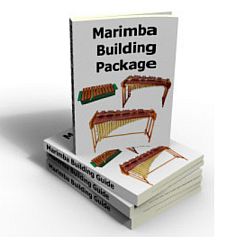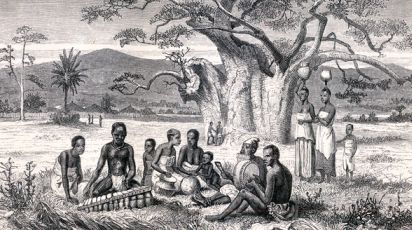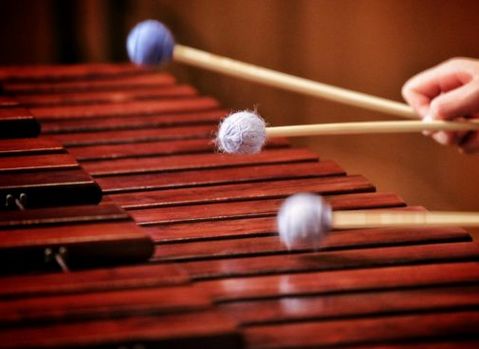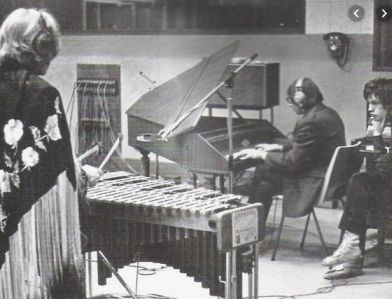How to Make A Marimba Review.

The Product: Make A Marimba
The Owner(s): Jim McCarthy.
Price: $173
Website: http://www.makeamarimba.com/buildamarimba/index.html
[toc]
>>Visit The Official Website<<
Jim McCarthy Story
In this review, we here at Review2Sound are going to take a look into this product by Jim McCarthy.
Make A Marimba is a step-by-step plan and video package which features how to make marimbas, vibraphones and xylophones. This is a fun and easy product of Jim McCarthy. You can have a broad range of pro mallet instruments and still have extra money to spare. If you can’t afford any commercial instrument, Make A Marimba gives you an alternative solution. This is also a way for a percussion student to have an affordable practice instrument at home.
Make A Marimba can be a real fun project to make for percussion players. This is also a good start for high school students to learn and love music early on. Jim is a master percussionist for more than 20 years now. It is his passion to build and design marimbas, particularly for other people. Despite his skills, he never considered himself as a pro woodworker or trader.
He builds these projects because he is a musician, and he can easily make those instruments. With his Make A Marimba, you can easily do it as well. You are no longer required to do any planning, designing and hard work. Jim got into acoustics when he had taken his master’s degree. He learned everything related to building marimbas. Out of his hobby, he made some world record bass marimbas.
Make A Marimba Features Overview.
The following are the Make A Marimba benefits:

- Permits usage of inexpensive materials.
- All plans include metric and imperial measurements.
- It does not need any woodworking skills.
- No need for expensive tools.
- Make home-made instruments and sound commercial-like.
Jim’s goals these days are more practical, and it’s evident with his Make A Marimba. He designs instruments for you and helps you save more money. He also builds other instruments like ultra large bass marimbas and small xylophones. The great thing about the Make A Marimba projects is that you can use any type of wood available. If you want to make glockenspiel and vibraphone, it is better for you to use standard metal stock.
Even without using African padouk or Honduras Rosewood, you can still make concert-quality marimbas. With the help of Make A Marimba, you can make these high-quality instruments using any hardwood. If you have decided on using the Make A Marimba package, you can have instant access to videos and e-books by downloading these. You can get started instantly. The Make A Marimba print out is in Adobe Acrobat Reader form.![]()
What You Get In The Product.
These are the items included in the Total Building Package of Make A Marimba:
- The Simple Glockenspiel Building Guide.
- The Box Resonated Xylophone E-Book Plans.
- The Two Octave Mini Marimba Plans.
- The P3 Three Octave Marimba Plans.
- The P524 Pro Concert Marimba Plans.
- The Three Octave Pro Vibraphone Plans.
- Mallet Making Guide e-book and video (free).
- One-Month Subscription to Percussion Keys Website (free).
I hope we helped you have a quick look at what Make A Marimba can offer you in this review. Now here is some general information about the marimba as an instrument and if this is something you would like to build or become involved with.
Frequently asked questions FAQs
Marimba history – Where did marimba originate come from?
The origins of the marimba are African. Mostly Eastern to southern African even though this instrument is now widely used across the whole continent. The name marimba stems from Bantu, malimba or marimba xylophone. It’s very difficult to pinpoint the exact place it originates from as their quite a few stories surrounding its creation. The most popular of which is that it was created by Queen Marimba who ruled over the Wakambi people in thenorthern part of the region now in the country of Tanzania.

This is a situation where different types the marimba were created by various peoples across the African continent but the credit to the original creators is mostly based on first contact with European scholars and historians. The instrument was introduced to South America in the early 16th Century by either African slaves who brought over the cultures, music centre additions or by pre-Columbian African contacts.
Instruments similar to the marimba.
While a xylophone, which is a modern version of this instrument (Xylophone means “wooden sound” in greek language), can be considered the most similar in looks and function to the marimba, there are many other instruments highly related to the marimba.

The kalimba, the traditional instrument of the Shona people of Zimbabwe, is considered a handheld version of this instrument.
What were marimbas used for?
Historically, marimbas were used by traditional Africans in ceremonies such as entertainment music, birthday celebrations, rituals, traditional festivals etc
Modern uses of the marimba include:
- Solo performances
- Jazz ensembles
- Brass ensembles
- Woodwind ensembles
- Marimba concerts,
- Indoor percussion ensembles
- Orchestral compositions
- Modern popular music and many more.
Type of best wood or timber used in a marimba? What kind of wood are marimbas made of?
When it comes to building the frame of the marimba instrument, the specific type of wood is not important at all. All you need for the frame is for it to be stable, durable and workable.
The best type of wood for a marimba instrument frame.
Keeping with the tradition of the local Africans that created this instrument, you can source whatever type of wood you have locally. Back when the marimba was instant originated created, locals used whatever they had available to them. Nothing was imported or sourced from so far away. The same is true today, get whatever you can locally as long as it’s easy to work and sturdy. Most marimba builders in the west use Ash wood to build the frame.
The best type of wood for a marimba instrument keys.
Traditional marimba builders called the type of wood they used, a wood that sings. This simply means that they use highly dense and resonating wood for the keys of the instrument. Here below is a list of types of wood with high resonance.
Honduran Rosewood
The most popular type of wood for the construction of marimba keys is the Rosewood. In the West, the Honduran rosewood (scientific name Dalbergia stevensonii) is highly regarded for its acoustic properties and excellent tap-tone. Not only is it popular for the construction of marimba and xylophone keys, but it is also used for acoustic guitars and author acoustic musical instruments. It is also used for veneer, speciality wooden sculptures and objects and fine furniture. Here below are some of the other related species of rosewood found across the world.
- African Blackwood (Dalbergia melanoxylon)
- Amazon Rosewood (Dalbergia spruceana)
- Brazilian Rosewood (Dalbergia nigra)
- Burmese Blackwood (Dalbergia cultrata)
- Burmese Rosewood (Dalbergia oliveri)
- Cocobolo (Dalbergia retusa)
- East Indian Rosewood (Dalbergia latifolia)
- Kingwood (Dalbergia cearensis)
- Madagascar Rosewood (Dalbergia baronii)
- Siamese Rosewood (Dalbergia cochinchinensis)
- Sissoo (Dalbergia sissoo)
- Tulipwood (Dalbergia decipularis)
- Yucatan Rosewood (Dalbergia tucurensis)
Due to its diminishing availability, it is priced relatively high compared to the form of wood available. Prices for rosewood are mid to high range compared to other imported wood types.
African Padoak
The African Padoak wood (scientific name Pterocarpus soyauxii) mostly found in central and tropical West Africa is originally a red-ish to pinkish-orange coloured wood. It started gaining popularity as a good type of wood for marimba and xylophone keys.
Common uses of this wood are flooring, tool handles, small speciality hold objects and sculptures and most importantly, musical instruments like the marimba.
Here are some related species of this wood
- Amboyna (Pterocarpus indicus)
- Andaman Padauk (Pterocarpus dalbergioides)
- Burma Padauk (Pterocarpus macrocarpus)
- Muninga (Pterocarpus angolensis)
- Narra (Pterocarpus indicus)
- Zitan (Pterocarpus santalinus)
While its tone is not as deep and rich as a rosewood, it’s popularity is influenced by its closeness to the original type of wood used by Africans to create original marimba instruments as well as its relative availability and low price.
Synthetic wood
Synthetic wood is a man-made wood type created from composite materials. Being a man-made material, synthetic marimba bars are very tough and weatherproof. Unlike natural wood, the weather is not a factor when it comes to where you can use the instrument. Whether it’s heavy rains, cold or hot weather, summer sun, synthetic water marimba keys will continue to play in the same tune except if they are physically damaged or altered.
The price and availability, as well as general toughness, makes them a very popular type of food for marimba and xylophone keys. It’s very important to note however that, synthetic marimba keys sound very differently from traditional rosewood marimba keys. Synthetic wooden keys tend to ring for much longer and have a “glassy” type of tone to them.
 What is a percussion mallet?
What is a percussion mallet?
To play the marimba or xylophone, you will need a mallet. Percussion mallets are objects used to strike a percussion instrument to produce sound. The term mallet is official but this instrument or tool is also known as a “beater”. For playing marimba or xylophone, wrapped mallets are usually used. They are wrapped with a softer material than the wooden/plastic or metal bars.
What are marimba mallets made of?
Marimba mallets can be made up of many various types and materials. The material at the end of the shaft is almost always a type of rubber, usually wrapped with yarn. The bars can be made of wood, metal, PVC, fibreglass and the list goes on and on. The head of the mallet, however, is usually made of soft material. It depends on how you want to play your instrument, as a hobby or professionally.
How does a marimba sound?
Here below is a video of a traditional marimba being played. You can hear its characteristic magical sounds and enjoy the skill of the musician playing the instrument.
How does a xylophone sound?
Here below is a video showing a xylophone being played. Very close to its traditional cousin, the marimba, xylophones also produce that characteristic sound and enjoyable music. Enjoy the skill of the musician playing the telephone in this video.
Most mallet heads are made of cord, yarn or rubber. You can make marimba mallets at home using household items. Here below his the link to an instructional post showing how to make home-made mallets using Yarn, Wool or Cord. https://www.instructables.com/id/Homemade-Marimba-Mallets/.
Professional mallets for playing professionally or in the more serious way, are available for sale. Even on online shopping sites like Amazon, you can find marimba mallets. Here’s the link to some of the best available on Amazon.
How long are marimba mallets marimba bar dimensions?
It all comes down to personal preference. Most marimba players prefer long-handled mallets while others prefer shorter and more direct mallets. You just have to try out for yourself what size your mallet should be that will give you a very nice blade experience. It is about how comfortable you are with your instrument. This is what will improve your overall playing skill and give you the most satisfaction.
What marimba mallets should I get?
You can make your marimba mallet at home or you can check here on Amazon for the most sought marimba mallets. Make sure to read well the reviews of other users to avoid pitfalls and problems.
What are the best marimba mallets that last the longest?
There is no best type of mallet for marimba. Depending on how you play your instrument, your mallet may or may not last long. If well-built with solid materials such as wooden or metal bars and a good mallet head, it can last much longer than a cheap or DIY one.
What instrument family does the marimba belong to?
The marimba is considered a percussion instrument. It is typically made up of a set of wooden bars which are struck with rubber or yarn mallets to produce music. There are also pipes or resonators which are suspended under the bars to increase the sound of the tones generated.
What does a marimba weigh?
Typically, the marimba is a very heavy and bulky musical instrument. The total weight of the marimba instrument will depend on its construction materials. The type of wood or metal frame, the type of resonators used and the type of wood or material used for its bars. For example, a Yamaha YM-5100A 5 Octave Professional Rosewood Marimba weighs in at about 211.5 lb which is around 96 kg.
Professional marimba musical instrument dimensions and size?
Using the same example above, a Yamaha YM-5100A 5 Octave Professional Rosewood Marimba is sized around 102 3/4″ by 40 1/2″ which is around 260 cm by 103 cm.
What is the typical range of the marimba instrument?
Most modern marimbas now have up to 5 octaves. C16-C76. this range now makes them very popular for modern music.
Marimba vs xylophone. Are marimba and xylophone the same instrument?
Main differences between the marimba and xylophone.
While the marimba and xylophone may look very similar, the core construction differs slightly. Usually, the tone plates/resonators of the xylophone the usually shorter and its mallet is usually made of rubber or plastic tip. Marimbas have longer resonators.
The marimba is usually the centre of attraction and is usually played as the main instrument of a show. Xylophones, however, are mostly used as part of a symphony orchestra.
The xylophone typically emits a much sharper tone compared to the marimba.
The marimba bars have a 3 to 5-octave range or higher while xylophones usually have a range of 2 1/2 to 4 octaves.
Is marimba or xylophone hard easy to learn?
The marimba or xylophone is a quite complicated instrument to play. That said, it’s a very entertaining musical instrument to try out. It will take a long time with constant practise to become very good at playing an instrument such as a marimba. Right from the first strike of a mallet on the marimba keys, you can already be considered a player of the marimba instrument. How well you play will be determined by your willingness to learn and consistency in practice.
 Top marimba playing bands
Top marimba playing bands
- Here below are some of the top marimba playing bands.
- African Dream Marimba Band
- US military Marimba playing Band
- Reg Kehoe and his Marimba Queens
- Tijuana Brass
Popular modern songs using the marimba.

Here below listed in alphabetical order, are some of the most popular modern songs and music you’ve heard probably on your radio or the Internet using this instrument.
- ABBA – Mamma Mia
- Aretha Franklin – Freeway of Love
- Betty Everett – The Shoop Shoop Song (It’s In His Kiss)
- Billy Joe and the Checkmates – Percolator (Twist)
- Captain & Tennille – Lonely Night (Angel Face)
- Coldplay – Mylo Xyloto
- Ed Sheeran – Shape Of You
- Edwyn Collins – A Girl Like You
- Gentle Giant – Funny Ways
- Gentle Giant – Isn’t It Quiet And Cold?
- Haircut 100 – Love Plus One
- Harper Simon – Leaves Of Golden Brown
- Iggy Pop – American Valhalla
- Kendrick Lamar – untitled 06 | 06.30.2014
- Lily Allen – Everyone’s at It
- Linkin Park – Shadow Of The Day
- Paramore – Ain’t It Fun
- Paul Simon – Hearts And Bones
- Peter Gabriel – No Self Control
- Primal Scream – Uptown
- Robert Palmer – Looking For Clues
- Silversun Pickups – Tapedeck
- Siouxsie and the Banshees – Hong Kong Garden
- Starbuck – Moonlight Feels Right
- Steely Dan – Rikki Don’t Lose That Number
- Taylor Swift – Wildest Dreams
- The Beach Boys – All Summer Long
- The Clash – The Street Parade
- The Cure – The Love Cats
- The Psychedelic Furs – Love My Way
- The Rolling Stones – Out Of Time
- The Rolling Stones – Sweet Black Angel
- The Rolling Stones – Under My Thumb
- The White Stripes – The Nurse
- Thompson Twins – Hold Me Now
- Violent Femmes – Gone Daddy Gone
In conclusion
I hope this review of the product “making a marimba” by Jim Mcarthy and the additional information provided about this wonderful instrument helps you make a decision. Please visit the product website if you want to learn how to build a marimba for yourself.
Do you have any experience with the marimba as an instrument or are you a marimbist? Feel free to share in the comments below.
Thanks for visiting. As always, I wish you all the best in your endeavours.
References cited
Technical information about wood species and type cited from https://www.wood-database.com